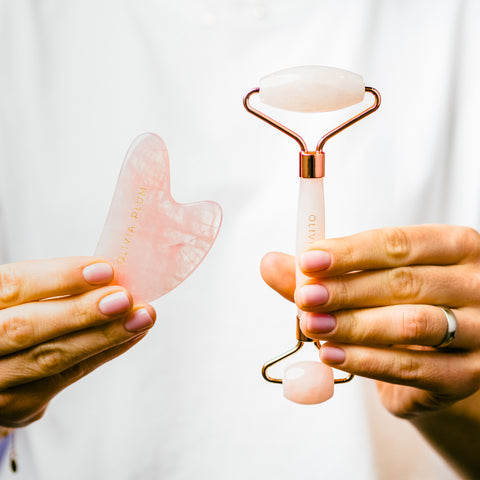What is the difference between a roller and a gua sha plate?
There is a lot of talk about the benefits of facial massage. But how to do it? Today we will look at the gua sha plate, a Chinese stone that will help you improve the condition of your skin and provide a natural lifting effect. You will also learn how the Gua Sha stone compares to a classic roller with stone rollers. Read and discover what the difference is between a Gua Sha roller and who we recommend these accessories to.

WHAT IS GUA SHA?
The most common names used here are stone or tile. Gua sha is a tool = a face (and body) massager made of natural stone, e.g. jade or quartz. It is used to "scrape the skin" using short or long strokes to stimulate circulation and increase blood flow. The facial Gua Sha plate is flat, oval and has rounded, smoothly polished sides. The Gua Sha massager has its specific shape and it is not accidental. Each side of the plate is intended for massaging a different part of the face and body. Use the longest, flat side to massage your forehead, neck and cheeks. Typically, one of the two longer sides has a small indentation, and one of the shorter sides ends in the shape of the letter V. Therefore, the Gua Sha stone may resemble a triangle or a heart, or less often - a comb.

HOW DOES A GUA SHA PLATE WORK?
Its operation is best explained by the name itself. GUA means "scrape" in Chinese and SHA means "red rash". And you can take it almost literally, because the massage with the plate is supposed to cause slight redness, which indicates that the flow of blood and lymph is improved. Thanks to this, the body naturally gets rid of toxins remaining in the tissues more effectively. It is also a sign of muscle activity - either in the body or facial muscles. Performed regularly (5-7 days a week) , Gua Sha facial massage tightens the skin and eliminates its sagging, shapes the facial contour, reduces fine wrinkles and adds radiance to the complexion. Facial massage is best performed after applying serum or oil to the skin.

WHAT IS A ROLLER?
A typical roller consists of two stone rollers (large and small) made of natural stone such as jade, rose quartz or opal. In fact, it is a kind of guasha tool, but in a simplified form, easier to use, especially at the beginning of our adventure with home massage.
Due to the fact that the massager is made of semi-precious stones, it is recommended to leave the accessory in a sunny place once every 2-3 weeks so that the stone retains its beautiful appearance and properties .

HOW DOES A ROLLER WORK?
The roller works more gently than the Gua Sha plate. A stone (preferably chilled) roller is the perfect tool if you are short on time and need a quick morning skin stimulation. Thanks to its gentle action, it can be used by anyone, even people with very delicate, sensitive and vascular skin, because it works by smoothing rather than scraping like Gua Sha. Its aim is to stimulate microcirculation and minimize swelling, resulting in a fresh and radiant complexion. The roller has a worse effect on facial oval and jaw modeling than Gua Sha. (The exception is the 3D roller , which has been adapted to work on the jawline.)

Regardless of which facial massage tool you choose, remember that any time is a good time to start taking care of yourself consciously. We have a real impact on 80% of the changes taking place in our body and face, but a holistic approach to care is important. To look good, we must maintain a healthy diet, exercise, get enough sleep, take good care of our skin - remember to remove make-up and use cosmetics appropriate to our skin type - and use supplementation. Include facial massage in your daily rituals and your face will thank you in a few years.

